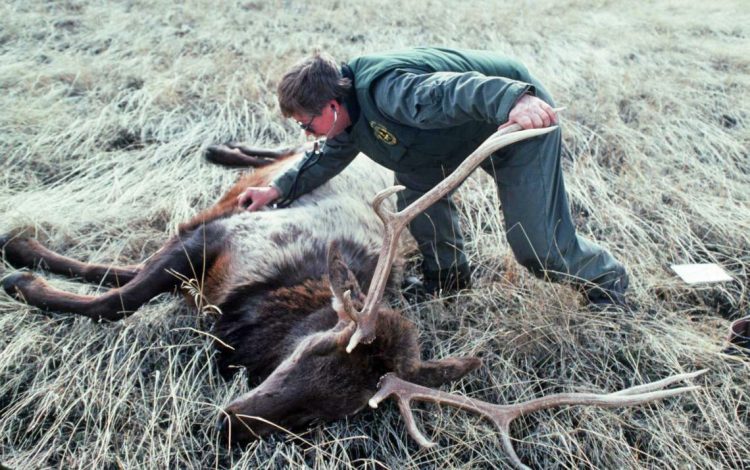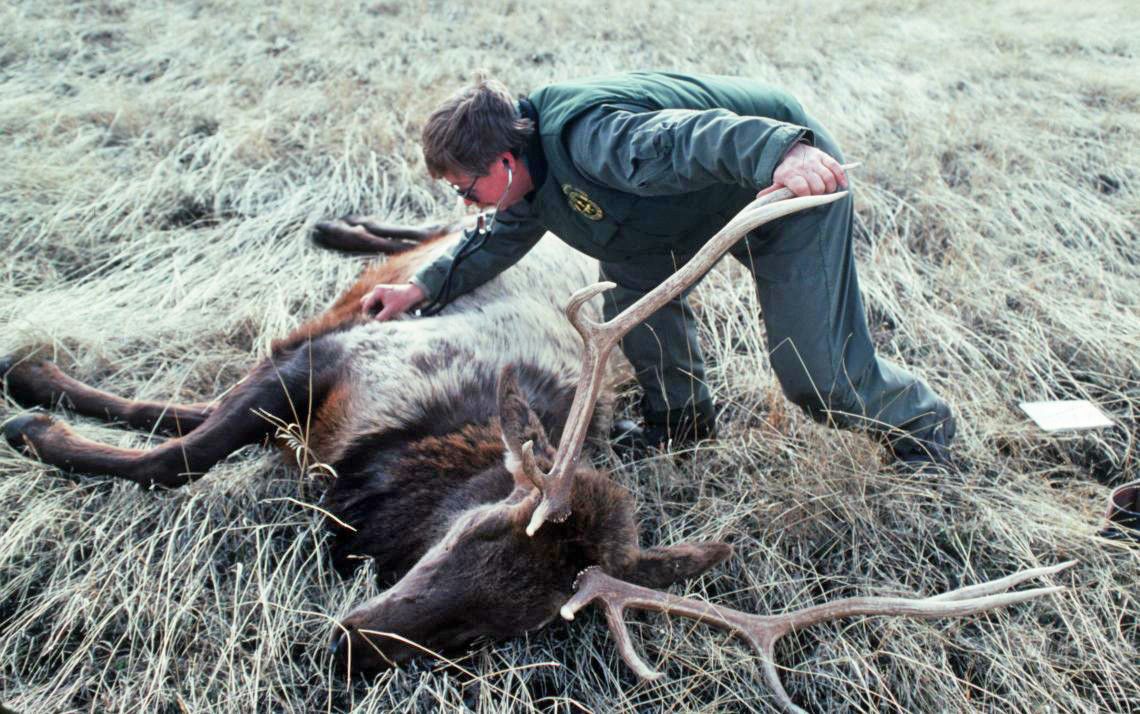
“We looked at the survival between migrants and residents and there was no difference even though winter habitat quality was a little better for residents. Survival was pretty darn high: 85 percent. We did have wolves in part of the study area. But the most common cause of death were cougars and domestic dogs.”
Nobody — no hunter, no poacher — has shot more moose in Washington than Woody Myers.
His weapon was a rifle. His aim: usually to save the animal’s life rather than kill it. His load, in most cases, was a tranquilizer dart.
Myers recently retired, adorned with achievements and awards, from a 40-year career with the Washington Department of Fish and Wildlife, mostly as a big-game researcher focused on deer and elk.
He’s credited with introducing the agency to helicopter net gunning as a capture technique as well as research using aerial telemetry and GPS tracking collars. Agency officials said Myers had a hand in capturing more than 1,600 ungulates — deer, elk, moose — and logging more than 3,500 hours in small aircraft, not to mention countless hours bouncing in pickups and some saddle time on horseback.
Myers, who lives north of Spokane Valley, credits his interest in wildlife to his grandfather, a chef who guided deer hunters, and his father, a career Air Force veteran who loved to hunt.
Anxious to continue the lineage, Myers said he saved his lawn mowing money for a year to buy his first shotgun at the age of 8.
While his father was stationed in Western Washington, Myers met an officer who had a degree in fisheries and wildlife. “Dave Narver was the first biologist I’d ever met,” Myers said. “He showed me slides of his undergraduate work with fish and wildlife in Alaska, and I thought holy crap, you can make a living doing that?
“So in fourth grade I decided I wanted to be a biologist.”
Myers had a notable mentor. Narver later ascended to the chief of the Fisheries Branch in the British Columbia Ministry of Environment. “What I remember most is that he could call ducks like nobody else,” Myers said.
One of Myers’ first jobs was working for Idaho Fish and Game on a fawn mortality study along the Idaho-Nevada border. “The state gave me a pickup and a trailer and I lived out in the mountains. What a way to spend a summer: tracking fawns, learning wildflowers, dodging rattlesnakes, taking pictures. It was just great.”
Myers began his Washington career in 1976 doing waterfowl work in the Columbia Basin. Later, he was a wildlife biologist out of Mount Vernon and a Deer and Elk Section manager in Olympia. He also was called once to be an undercover officer in a poaching bust. “I remember my throat being really dry,” he said.
He carved his niche into the big leagues of research starting in 1985 with a move to the Methow Valley to lead the Okanogan Mule Deer Study.
The department’s current director, Jim Unsworth, singled out Myers’ expert testimony in a federal court case as one of his most far-reaching contributions to wildlife conservation.
Based on his expertise in the Okanogan study, Myers took the stand in what became a test for the National Environmental Policy Act, Unsworth said. He was able to detail the potential impacts of development, including a proposed ski area, on mule deer migration corridors in the Methow Valley.
The case was reviewed by the United States Supreme Court, which upheld the lower court’s decision in favor of protecting mule deer habitat.
Net-gunning big game from helicopters and shooting tranquilizer darts are research capture-and-release methods Myers brought to Washington in 1986 for studying the Okanogan deer, the largest migratory mule deer herd in the state.
Many of the helicopter techniques were perfected in New Zealand, but it was California researchers who convinced Myers that flying down within feet of fleeing animals and firing a firearm to propel a net for capturing them is an efficient and cost-effective method, he said.
Helicopters are expensive to charter, but they can cover a larger area in less time and require fewer people in the field than other capture methods.
“But it’s dangerous,” he said.
After being trained by a net-gun manufacturer, Myers was invited by California Fish and Game biologists to train with them as they netted bighorn sheep. “Luckily, deer started moving early that fall for our Methow research and I had to stay in Washington to document migration corridors and do what we could to protect them in lieu of the development expected to occur through the valley,” Myers recalled.
“Shortly after I canceled on the California invitation, I learned that the group I was supposed to fly with crashed and everyone was killed.”
Myers said he and a pilot walked away from one helicopter hard landing during his career. “And I can tell you it gets really quiet in an airplane when the engine quits,” he said. “All you hear is wind. In my case, the pilot was able to restart the engine after losing about 500 feet.”
Fish and Wildlife enforcement officers have a dangerous job, especially during fall when virtually everyone they encounter is armed, Myers said.
“Statistically, however, biologist jobs are dangerous, too, because of their use of boats and aircraft. More biologists die than law enforcement officers. And we get beat up in traps by a lot of deer.”
Myers was a quick study in gunning game with nets or darts while strapped to the side of a speeding chopper.
“Shooting a dart is like shooting a rifle only at much slower velocity,” he said. “When shooting from a helicopter, you’re not aiming down the barrel. It’s instinctive. The pilot gets you fairly close, maybe 15 feet sometimes. You point a little behind the animal because you’re coming in faster than it is running.”
Elk line out and are fairly easy to hit, but deer change direction like rabbits. Shooting anything at an animal is serious business, he said.
“Those darts can be projectiles that can penetrate the body cavity if the charge is too hot,” he said. “I’ve lost a few animals trying to tranquilize them. It’s a bad feeling to kill an animal when you’re ultimately trying to do good for them.”
Capturing big game was only the beginning of several high-profile wildlife studies Myers orchestrated in Washington.
As the data is analyzed for years after a major study, the results can be misinterpreted by the public and even by other wildlife professionals.
One of the facets of five years of field work in the Blue Mountains looked at how elk calves die. “Cougars were the number one cause followed by black bears,” he said, noting that some people locked onto the loss of half the calves with no perspective.
“The upshot was that overall calf survival was relatively high. The mean was a 45 percent survival rate. Anytime your surviving half of a neonatal ungulate population, that’s pretty darn good.”
The limiting factors for the elk herd also involved drought, compromised habitat, poaching and depredation control and “cow tags” to protect farm and ranch crops. Calves were surviving well enough for the elk herds to grow, but tolerance for elk is a perennial factor where elk range blends into private property, he said.
Most recently, he completed a six-year study on whitetails in northeastern Washington. “We learned that about 60 percent of the whitetails in Units 117 and 121 were migratory adult females.
“We looked at the survival between migrants and residents and there was no difference even though winter habitat quality was a little better for residents. Survival was pretty darn high: 85 percent. We did have wolves in part of the study area. But the most common cause of death were cougars and domestic dogs.”
The management decisions based on his research is in the hands of wildlife managers who also must consider social and political factors. “As a researcher, I present the data,” he said.
In 1999, Myers collaborated with researchers, universities, schools and volunteers from sportsmen’s clubs as project leader for the Eastern Washington Cooperative Mule Deer Project.
Source: Washington big game researcher reflects on lifetime with wildlife | Outdoors | billingsgazette.com

Comments
They need to stop killing all of them and let them be
They will not without being legally made to. Please Support our Research to do so.
Without wildlife biologists, ecologists, and ethologists, we would know very little about the lives of other animals than ourselves.
Too utilitarian viewpoints have dissociated us from the other lives and minds of the earth.
So we can only thank individuals like Myers, for hopefully changing human course away from extinction of vertebrate life.
Mule deer in the more vertical topographies of parts of the west are migratory in the sense of seasonally traveling the same paths, with a relatively small proportion dispersing and flowing genetic diversity across landscapes.
Varying weather helps them make foraging choices and knowledge of new water sources.
While hte simple expalnations for instances such as the kaibab deer irruption and later habitat changes elsewhere positing only single factors, yet predators cause cascades, weather causes other migration and dispersal, still, without such important components as predators, Darwin and Malthus were correct in claiming that populations can increase until habitats cannot sustain them.
so, in the modern human-dominate world, we have to protect against the habitat fragmentation and barriers erected by our own population, AND make sure that Leopold’s save every cog in his imaginary machine (think better: save every immune system component; save apoptosis to protect from cancer and dull stasis that would otherwise preclude neurogenesis, memory, healing of skin scrapes, that instead would have mortal consequences for the whole) remains functional.
Wolves must return in ecologically effective numbers.
If they control coyotes greater fawn survival of pronghorns, greater fox survival leading to better rodent control by the wild system, and unknown cascades lace together, beyond the understanding of humans.
Yet, we hav enot so far allowed return to ecologically effective numbers, as game farming “management” and primate fear prevent proper ecological and complex systems from reforming.
Some previous experiments with closed ecosystems created only to support humans have all failed. Dmoestic-style thinking – management is a case of this.
Originally, management limits were established to prevent the crashing ungulate populations suffering from excessive bushmeat trqade in the usa, and carzed bison killers, – read the contemporary descriptions!.
Problematically, these were put in place by such as bespectacled trophy/pleasure hunter Roosevelt, who expresssly hated wolves. His benighted game farming exclusio of predators that improved ungulate health, continued the Euroamerican legacy of “kill anything that does not appear to benefit your accumulation endeavors.”
This has led to such as admitted wolf-hater Valerius Geist, a product of the flawed simplistic manage-for-human-benefit ideation called “North American Model of Wildlife Conservation.”
While proven flawed, even the most obviously ridiculous schemes and confabulations persist because of the incapacity of self-interest-biased humans to understand or respect that nature is too complex for them to understand, and therefore, complete conservation, with open habitat linkage, necessities, are not yet policy.